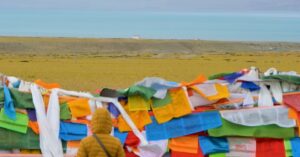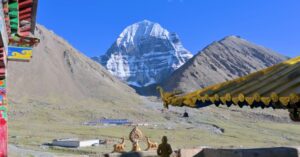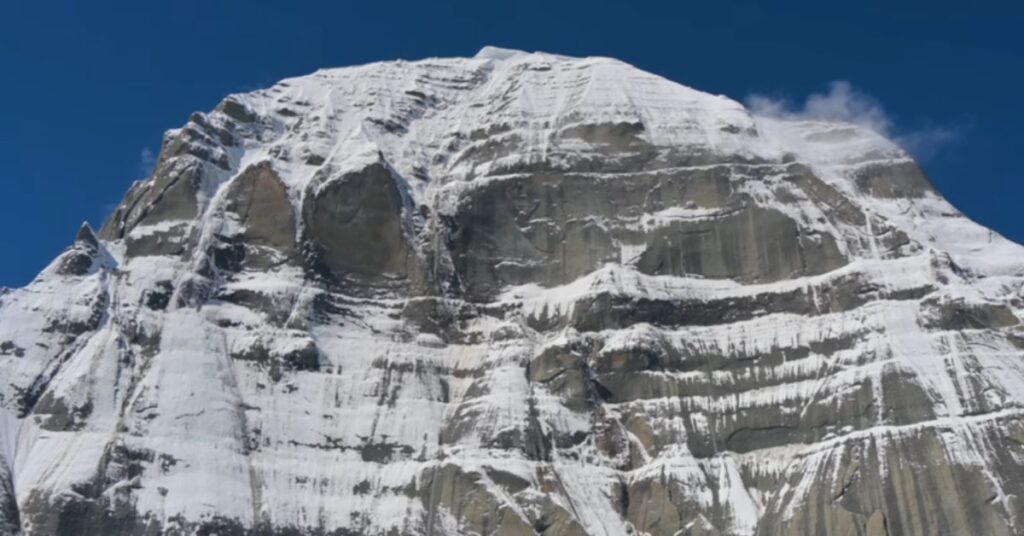Many trekking and religious pilgrimages consider Mount Kailash to be a heavenly sanctuary known as the “Stairway to Heaven.” Millions from across the world seek spiritual meaning at Kailash because they recognize it as a divine natural beauty combined with its religious value. Visitors who travel to this sacred religious centre often discover that the journey involves physical and mental resilience testing trekking alongside profound emotional and spiritual growth.
People who undertake the pilgrimage to Mount Kailash must combine their spiritual journey with their physical ability to complete the challenge. At 6,638 meters in height, Mount Kailash stands in the Tibet Autonomous Region as a sacred site for Hindu, Buddhist Jains and Bon practitioners. According to religious belief, the full parikrama (circumambulation) of this mountain serves to cleanse people’s spirits from sin.
The journey that leads to Mount Kailash exists beyond typical travel adventures. Travelling to Mount Kailash stands as one of the most difficult challenges among all exploration routes because it combines dangerously high elevations with intense weather conditions. Altitude sickness requires thorough understanding accompanied by appropriate preparation and awareness to ensure safety during the journey.
This spiritual journey puts travellers’ bodies beyond their normal physical boundaries. Oxygen levels remain considerably lower across this region because it is located between 4,500 meters and 5,800 meters above sea level. Proper preparation becomes necessary for preventing elevation sickness because failure to prepare can transform a spiritual quest into a risky journey. No spiritual journey to Mount Kailash succeeds without proper management of altitude sickness conditions because your safety depends on it.
This guide provides everything needed to trek to Mount Kailash in a way that ensures both safety and fulfilment.

Understanding Altitude Sickness (AMS): Why It can be Threat During Kailash Mansarovar Yatra
Kailash Mansarovar is located in Tibet, which is also known as the autonomous part of China. Tibet is also called the roof of the world because it is located at a high altitude. The average altitude of Tibet is approximately 4,380 meters (14,370 feet) above sea level. During the Yatra to Kailash Mansarovar or Kailash Kora, you need to cross the challenging Dolma La Pass, which is located at an elevation of 5,636 meters (18,525 feet).
Altitude sickness is a condition when the trekkers fail to adapt to the high level of altitude due to the low amount of oxygen present in the air. The risk of altitude sickness increases when you reach an altitude of above 3,000m. So during the Kailash Mansarovar Yatra some trekkers find difficulties while trekking in high altitude due to the effect of altitude sickness.
Types of altitude sickness
- Acute Mountain Sickness(AMS): Acute mountain sickness, which is the initial stage of mountain sickness, is the most common type of altitude sickness. AMS is manageable with proper rest and acclimatization.
Here are the common symptoms of AMS you need to be careful while heading for the Kailash Mansarovar Yatra:
- Headache
- Nausea or vomiting
- Dizziness or lightheadedness
- Fatigue or weakness
- Loss of appetite
- Difficulty sleeping
- HAPE (High-Altitude Pulmonary Edema): HAPE is the advanced form of AMS, which happens when the trekkers neglect the early symptoms of AMS. During this stage, trekkers can experience chest tightness, difficulty in breathing, and fluid builds up in the lungs. Trekkers find difficulty or symptoms get worse especially at night time or during physical activity.
- HACE (High-Altitude Cerebral Edema): HACE is a severe form of altitude sickness which can result in swelling in the brain, resulting in severe headaches, confusion, loss of coordination, and altered mental states. HACE can be life-threatening if left untreated.
Individual Susceptibility and Risk Factors
Not everyone experiences the AMS, so here are some risk factors that trekkers might face altitude sickness during the Kailash Mansarovar Yatra:
- Previous experience: If you have a history of experiencing AMS while trekking at high altitudes.
- Rate of ascent: Rapid climbing at high altitude results in less time to adapt your body.
- Fitness level: Although physical fitness doesn’t make you immune to AMS it can help to recover faster when you acclimatize properly.
- Age and medical conditions: Old age people with pre-existing health conditions like heart and lung issues can face higher risks of AMS.
- Dehydration: Dehydration in the body can trigger AMS symptoms.
Pre-Trip Preparation: Kailash Mansarovar Yatra
For the smooth journey of the Kailash Mansarovar Yatra from Nepal, it is important for trekkers to strictly follow some major pre-preparation tips. Here is how you can prepare in advance before booking the Kailash Mansarovar Yatra Package.
Maintain Physical fitness:
Trekkers who intend to complete the Kailash Mansarovar Yatra must be in good physical condition because it is regarded as a moderate to difficult trek. Especially during the Kailash Kora, they must be able to walk at high altitudes every day for around 5-7 hours in difficult terrain conditions.

So they must have strong legs and high stamina. Here are some exercises that you can practise every day for around 1 -3 hours before attempting the Kailash Mansarovar Yatra.
- Cardiovascular exercise: Running or jogging, Cycling, Swimming, Jump rope, High-Intensity Interval Training (HIIT)
- Strength-building exercises: Push-ups, Squats, Deadlifts, Bench presses, Pull-ups
- Flexibility: Yoga (e.g., Downward Dog, Cobra Pose), Pilates, Forward bends, Shoulder stretches, Hamstring stretches
Medical check-up and vaccinations:
Before heading for the Kailash Mansarovar Yatra, it is best to do the pre-medical check-up. It is because this trek poses some risks and challenges, especially during the Kailash Kora, like physical demand, altitude sickness and unpredictable weather changes.
Key Things to Check
- Cardiovascular health and lung function
- Blood pressure levels
- Any history of altitude sickness or related issues
Although nobody will ask about the vaccination card we highly suggest that you are up to date on necessary vaccinations. Discuss with your Doctor about specific vaccinations such as:
- Hepatitis A & B
- Typhoid
- Tetanus
- Influenza
On the Mountain: Acclimatization & Prevention
To remain healthy and safe during the Kailash Mansarovar Yatra, proper acclimatization plans and preventative techniques are crucial. Below is a comprehensive guide that will help you to manage and handle difficulties.

Gradual ascent and rest days
One of the most important elements for a high-altitude trek like the Kailash Mansarovar Trek is climbing gradually. Climbing gradually reduces the symptoms of altitude sickness and helps your body adapt to the altitude. During the Kailash Mansarovar Yatra, rest days are kept in the itinerary so that trekkers can take time to relax, recover muscle, hydrate and nourish the body. Additionally, follow the climbing rule of thumb, which states that once you reach 3,000 meters, you should not climb more than 300 to 500 meters each day.
Hydration: Importance of drinking plenty of water
Hydration is part of the Acclimatization strategy, which helps to stay healthy and reduce the negative effect of altitude on the trekkers’ body during the Kailash Mansarovar Yatra. Aim to drink at least 3-4 litres of water daily during the trek. Along with water, it is also best to add drinking soups, herbal teas, or electrolyte solutions to your meal. Furthermore, alcohol and caffeine should be avoided as they might further dehydrate the body and hamper acclimatization.
Diet: Foods to eat and avoid at high altitude
Your trekking agency will take care of your meals during the Kailash Mansarovar Yatra because only Tibetan cuisine is available in Tibet. Although you are given three meals, we should be concerned about the best food to eat while trekking. You should eat food that is high in protein and carbohydrates, fresher food rich in minerals and vitamins and which is easy to digest.
You should avoid foods that are hard to digest, like red meat, which may cause bloating or discomfort at high altitudes. Also, avoid high-sugar snacks and carbonated drinks. Instead, Carry high-energy snacks like nuts, seeds, and energy bars for quick boosts during Kailash Mansarovar Yatra.
Monitoring for symptoms
While you are on a trip to the Kailash Mansarovar Yatra, especially at high altitude, monitoring the early symptoms of altitude sickness is crucial. If altitude sickness is not controlled in the early stage then it can cause some serious problems later. If you experience mild symptoms during the Kailash Mansarovar Yatra, stop for a while. Rest, hydrate, and eat some light food and inform your guide about the situation. If symptoms worsen, then descend to a lower altitude and ask for medical attention if necessary. Always follow your guide’s instructions, and don’t neglect any symptoms of altitude sickness.
Managing AMS Symptoms
As you know, prevention is better than treatment, so you need to know when to handle the AMS. Follow this life-saving tips throughout your Kailash Mansarovar Yatra to minimize the risk:
- Ascend gradually so that your body has time to adjust to each new altitude.
- Throughout the hike, drink plenty of water and take tiny sips as needed.
- For long-lasting energy, have light, well-balanced meals high in carbohydrates.
- Steer clear of large meals, alcohol, and caffeine, as these can hinder acclimatization.
- To improve your lung capacity, include breathing techniques like pranayama in your preparation routine.
- Keep an eye out for signs on both your team and yourself, and don’t be afraid to express your issues if you feel ill.
Medications and Supplements: Acetazolamide (Diamox), Ibuprofen, Herbal Remedies
Here are some famous medications and supplements that can be helpful for you, Kailash Mansarovar Yatra.
Acetazolamide (Diamox) for Altitude Sickness Prevention
Acetazolamide, which is also known by the brand name Diamox, is very popular among trekkers and is used as a medication for altitude sickness. It helps to reduce the chances of developing altitude sickness symptoms. For the dose and precaution we suggest you consult with the Doctor first before taking it. Keep in mind that once you develop the symptom this medicine will not work. It is not a cure for AMS but only works as a preventive measure.
Ibuprofen for Pain Relief
Headaches and tired muscles are common during the long hours of driving and walking at high altitudes during the Kailash Mansarovar Yatra. So you can use these painkillers to reduce the headache, general inflammation and soreness from trekking.
Herbal Remedies for General Well-Being
Some herbal medicines such as Garlic and Tulsi (Holy Basil), Often used in teas, Ashwagandha, Mint tea and Ginger Tea or Ginger Chews, also help enhance your overall health during the Kailash Mansarovar Yatra.

Dealing with common ailments: Digestive issues, sunburn, cold and cough
On the Mount Kailash Yatra, you might face digestive problems, sunburn, or a cold but it can be managed when taken care of. To avoid stomach issues, you can drink clean water, eat simple cooked food, and avoid raw or heavy meals. For sunburn, use high SPF(50++) sunscreen, wear protective clothes and wear sunglasses. To prevent colds or coughs, dress warmly, stay hydrated and drink warm drinks.
What to pack in your medical kit: Essential medicines and first-aid supplies
For the Kailash Mansarovar Yatra, you can pack the following things in your medical kit.
- Pain relievers: Ibuprofen/Paracetamol
- Altitude sickness prevention medication: Acetazolamide
- Digestive aids: Antacids, ORS, Loperamide
- Cold and allergy: Throat lozenges, Decongestants
- Additional: Adhesive bandages, antiseptic cream, gauze, tweezers, medical tape, sunscreen (SPF 50+), lip balm, insect repellent and Thermometer
Staying warm and comfortable: Layering, appropriate clothing and gear
To make your Kailash Mansarovar Yatra smooth and comfortable you must pack proper layers of cloth and gear items to handle the varying weather conditions. Be careful not to overpack, and when packing, make sure you pack everything. A lightweight down jacket, a warm sleeping bag, and comfy trekking boots are essentials for staying warm and prepared for the journey.
Final Say
A renowned spiritual and adventurous yatra that has the potential to change lives is the Kailash Mansarovar Yatra. For followers from all over the world, this holy journey is a must-visit destination once in their lifetime. This yatra to Kailash Mansarovar offers you the chance to visit and explore Mt. Kailash, which is the home of Lord Shiva, and Lake Manasarovar, which is believed to purify the soul. This spiritual and divine place tests your endurance and determination, so it is important to prepare well in advance.







